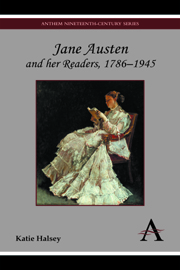Book contents
- Frontmatter
- Contents
- Acknowledgements
- Part One
- Part Two
- Introduction
- 4 Austen's Readers: Contexts I
- 5 Austen's Readers: Contexts II
- 6 Austen's Readers I: Affection and Appropriation
- 7 Austen's Readers II: Opposition and Resistance
- 8 Austen's Readers III: Friendship and Criticism
- 9 Austen's Readers IV: Sociability and Devotion
- Conclusion
- Notes
- Bibliography
- Index
4 - Austen's Readers: Contexts I
from Part Two
Published online by Cambridge University Press: 05 July 2012
- Frontmatter
- Contents
- Acknowledgements
- Part One
- Part Two
- Introduction
- 4 Austen's Readers: Contexts I
- 5 Austen's Readers: Contexts II
- 6 Austen's Readers I: Affection and Appropriation
- 7 Austen's Readers II: Opposition and Resistance
- 8 Austen's Readers III: Friendship and Criticism
- 9 Austen's Readers IV: Sociability and Devotion
- Conclusion
- Notes
- Bibliography
- Index
Summary
Before turning to consider individual readers in detail, it is important to sketch out some of the significant contexts within which readers encountered Austen's works. As Anthony Mandal has recently brilliantly demonstrated, placing Austen's novels within the context of the late eighteenth and early nineteenth-century publishing trade allows us to better understand both her novels and their relationship to the popular fiction of her period. Here, we will deal first with the material qualities of the books in which the works were found, since these can play an important part in influencing readers. When Charlotte Brontë first came across Pride and Prejudice in late 1847, she wrote to G. H. Lewes of the ‘accurate daguerrotyped portrait of a common-place face’ that she found in it. Most critics take this to be a metaphorical description, but as Brian Southam points out, ‘“commonplace” engraved portraits of Elizabeth Bennet face the reader on the title-pages of Bentley's 1833 edition of Pride and Prejudice’. Were Brontë's responses to reading Austen coloured by the kinds of illustrations she encountered in the novel? Was she, consciously or unconsciously, influenced by them? Without knowing which edition Brontë was reading, it would be impossible to know the extent to which Charlotte Brontë's impressions of Austen's work – ‘an accurate daguerreotyped portrait of a common-place face; a carefully fenced, highly cultivated garden, with neat borders and delicate flowers; but no glance of a bright, vivid physiognomy, no open country, no fresh air, no blue hill, no bonny beck […] elegant but confined houses’ – represent descriptions of actual illustrations, metaphorical descriptions of Austen's writing, or a combination of the two.
- Type
- Chapter
- Information
- Jane Austen and her Readers, 1786–1945 , pp. 101 - 116Publisher: Anthem PressPrint publication year: 2012

